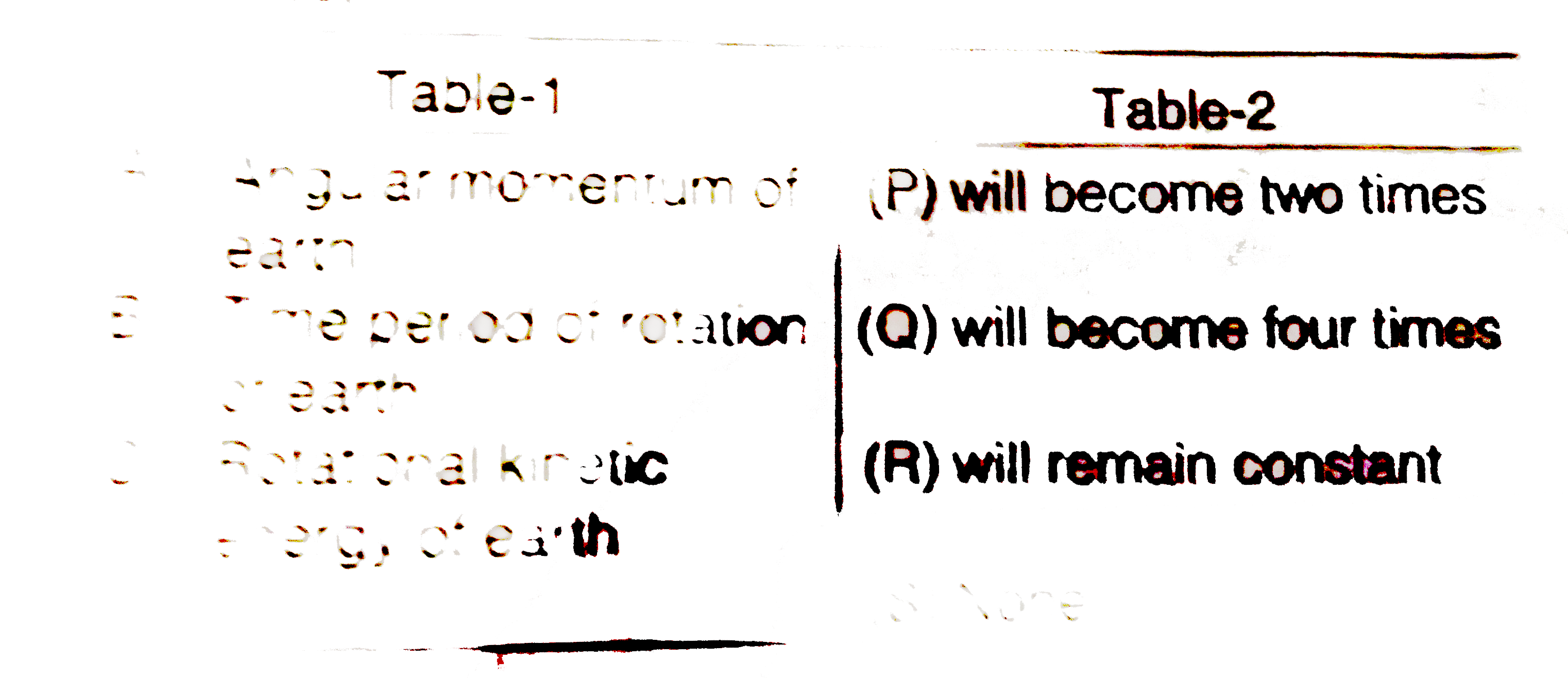If the earth shrinks such that its mass does not change but radius decreases to one-quarter of its original value then one complete day will take
96 h
48 h
6 h
1.5 h
The correct Answer is:D
To solve the problem, we need to analyze the situation where the Earth's radius decreases to one-quarter of its original value while its mass remains unchanged. We will use the principles of conservation of angular momentum and the formulas for moment of inertia and angular velocity.
1. Understand the Initial Conditions:
- Let the original radius of the Earth be R.
- The mass of the Earth is M.
- The initial moment of inertia Ii of a solid sphere is given by:
Ii=25MR2
- The initial angular velocity ωi can be calculated using the period of rotation (1 day = 24 hours):
ωi=2πTi=2π24×3600 rad/s
2. Determine the Final Conditions:
- The new radius Rf is:
Rf=R4
- The final moment of inertia If is:
If=25MR2f=25M(R4)2=25MR216=180MR2
3. Apply Conservation of Angular Momentum:
- Since there is no external torque acting on the Earth, angular momentum is conserved:
Iiωi=Ifωf
- Substituting the expressions for moment of inertia:
25MR2⋅ωi=180MR2⋅ωf
- Cancel M and R2 from both sides:
25ωi=180ωf
4. Solve for Final Angular Velocity:
- Rearranging gives:
ωf=25⋅80⋅ωi=32ωi
5. Relate Angular Velocity to Time Period:
- The relationship between angular velocity and the time period is:
ω=2πT
- Therefore, the final period Tf is:
Tf=2πωf=2π32ωi
- Since Ti=24 hours:
Tf=Ti32=24 hours32=34 hours=1.5 hours
Final Answer:
One complete day will take 1.5 hours.
- Let the original radius of the Earth be R.
- The mass of the Earth is M.
- The initial moment of inertia Ii of a solid sphere is given by:
Ii=25MR2
- The initial angular velocity ωi can be calculated using the period of rotation (1 day = 24 hours):
ωi=2πTi=2π24×3600 rad/s
- The new radius Rf is:
Rf=R4
- The final moment of inertia If is:
If=25MR2f=25M(R4)2=25MR216=180MR2
- Since there is no external torque acting on the Earth, angular momentum is conserved:
Iiωi=Ifωf
- Substituting the expressions for moment of inertia:
25MR2⋅ωi=180MR2⋅ωf
- Cancel M and R2 from both sides:
25ωi=180ωf
- Rearranging gives:
ωf=25⋅80⋅ωi=32ωi
- The relationship between angular velocity and the time period is:
ω=2πT
- Therefore, the final period Tf is:
Tf=2πωf=2π32ωi
- Since Ti=24 hours:
Tf=Ti32=24 hours32=34 hours=1.5 hours
One complete day will take 1.5 hours.
Similar Questions
If the earth shrinks such that its density becomes 8 times to the present values, then new duration of the day in hours will be
View SolutionIt is found that on heating a gas its volume increases by 50% and its pressure decreases to 60% of its original value. If the original temperature was −15∘C, find the temperature to which it was heated.
View SolutionActivity of a radioactive sammple decreases to (1/3)rd of its original value in 3 days. Then, in 9 days its activity will become
View SolutionIf the radius of earth contracts 1/n of its present day value, the length of the day will be approximately
View SolutionWhat would be the charge in radius of nth orbit, if the mass of electron reduces to half of its original value ?
View SolutionWhat would be the change in radius of nth orbit, if the mass of electron reduces to half of its original value ?
View SolutionHow does the weight of an object vary with respect to mass and radius of the earth. In a hypothetical case, if the diameter of the earth becomes half of its present value and its ,mass becomes four times of its present value, then how would the weight of any object on the surface of the earth be affected?
View SolutionRadius of a circle is one-half of its ......
View SolutionIf the earth suddenly shrinks (without changing mass) to half of its present radius, then acceleration due to gravity will be
View SolutionIf radius of earth is reduced to half without changing its mass,

View Solution
